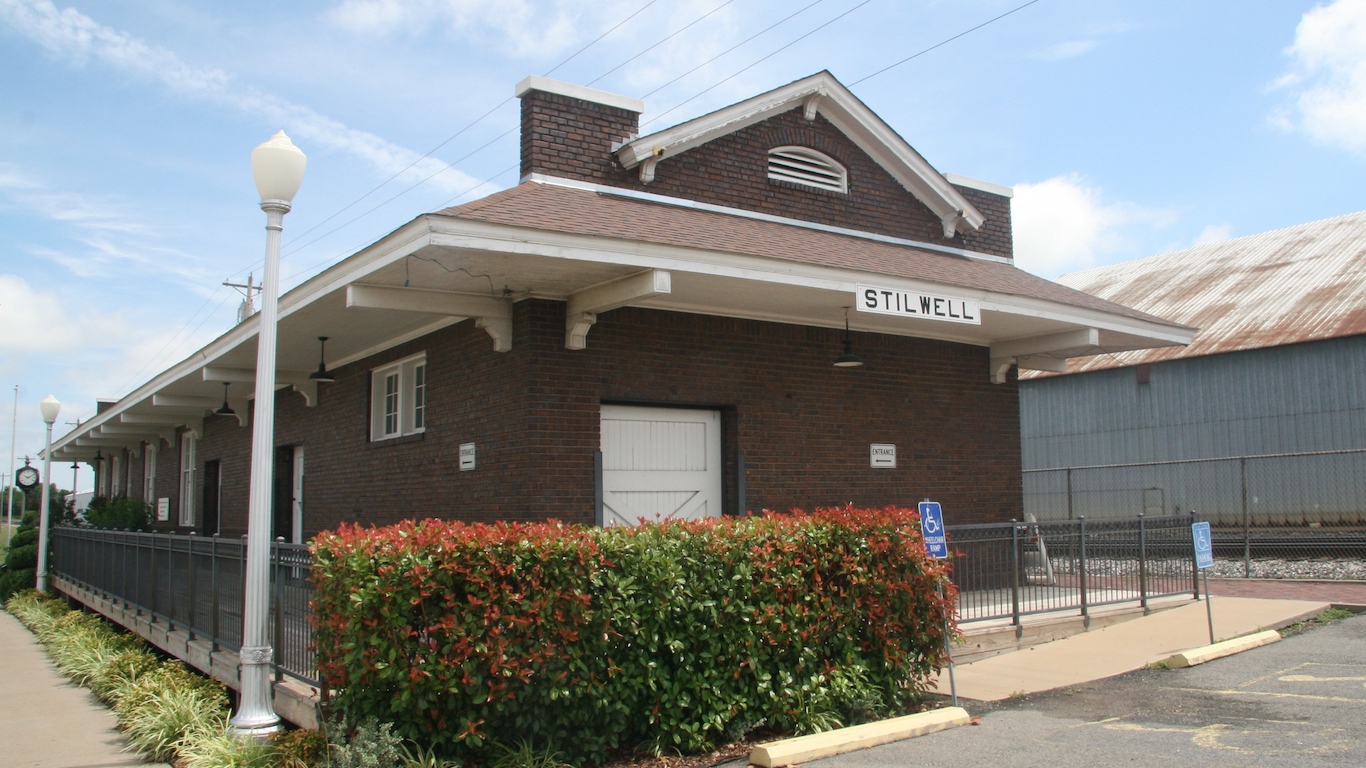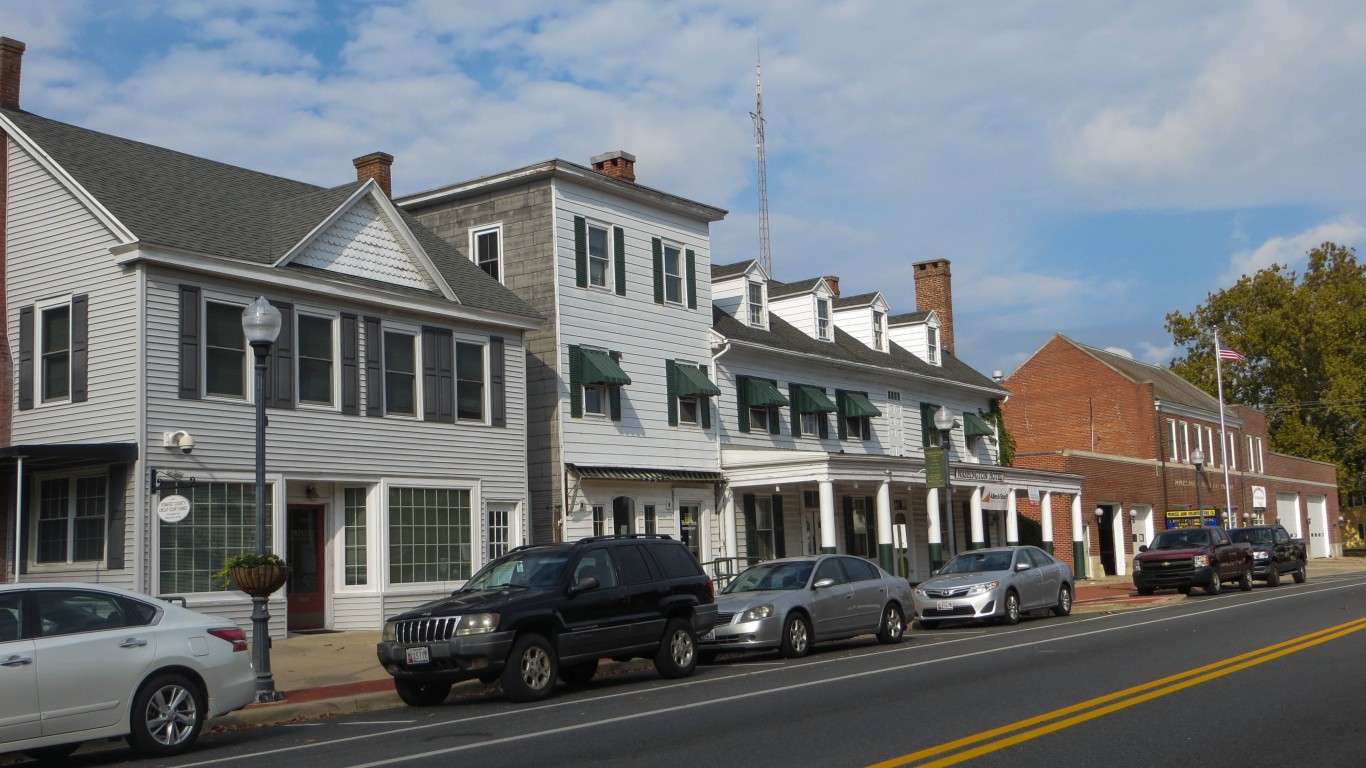
Life expectancy in the U.S. has dropped a full year in the first half of 2020 — the biggest decrease since World War II — largely due to the COVID-19 pandemic. The disease has had a large impact on older Americans and people with certain health conditions that increase the risk for severe illness from COVID-19.
Some of the components of a healthy lifestyle that people have control over are sticking to a nutritious and well-balanced diet, regularly exercising, and refraining from harmful habits like smoking. But there are large populations across the country that, for different reasons, fail to adhere to these guidelines. And the consequences are evident among across the U.S., from state to state, and from county to county.
To identify the least healthy county in every state, 24/7 Tempo reviewed data on behaviors and outcomes in all 3,142 U.S. counties and county equivalents from County Health Rankings & Roadmaps, a Robert Wood Johnson Foundation and University of Wisconsin Population Health Institute joint program.
The overall health of a population is closely linked to certain social and economic conditions. Unfortunately, access to health care as well as to healthy diets and lifestyles appear to be out of reach for many low-income Americans.
In 48 of the 50 counties on this list, the poverty rate exceeds the statewide poverty rate – in several cases it is more than double — and many of the least healthy counties in their state also rank as the poorest county in that state. Not only can low-income Americans afford fewer healthy options, but poverty itself is associated with stress that can undermine both physical and mental health.
Americans who do not lead healthy lifestyles may be at increased risk of certain serious diseases and conditions, including heart disease, diabetes, and certain cancers. These are the states where cancer kills the most people.
In many of the counties on this list, whose residents tend to report less healthy behaviors, residents also tend to report more days of feeling physically and mentally unwell a month than the average statewide. Similarly, all but one of the counties on the list have a premature death rate — number of deaths before age 75 per 100,000 population — that is much higher than the rate of their home state.
Click here to see the least healthy county in every state
Click here to read our detailed methodology

Alabama: Conecuh
> Adults in fair or poor health: 28.6% (county) 22.0% (state)
> Adult obesity rate: 43.0% (county) 35.5% (state)
> Adult smoking rate: 21.1% (county) 20.9% (state)
> Adults with no health insurance: 12.7% (county) 9.5% (state)
> County population: 12,394
> Largest city: Evergreen
Of the 67 counties in Alabama, Conecuh ranks as the least healthy. About 43.0% of adults in the county are obese, well above the 35.5% share of adults statewide and one of the highest obesity rates of any county in the U.S.
Low-income Americans tend to have less access to quality health care. Economic conditions partially explain the poor health outcomes in the southern Alabama county, where the median annual household income is $37,834, about $12,000 less than the state median of $50,536.
[in-text-ad]

Alaska: Aleutians East
> Adults in fair or poor health: 16.8% (county) 18.1% (state)
> Adult obesity rate: 50.5% (county) 32.5% (state)
> Adult smoking rate: 16.6% (county) 21.0% (state)
> Adults with no health insurance: 46.3% (county) 13.6% (state)
> County population: 3,385
> Largest city: Sand Point
Unhealthy behaviors, particularly not exercising, likely contribute to Aleutians East’s ranking as Alaska’s least healthy borough. About 30.0% of adults report not exercising on a regular basis, 10 percentage points more than the 20.0% of adults statewide reporting not exercising. One in every two county adults is obese, the seventh-largest share in the country and significantly larger than the state obesity rate of over 32.5%.
Nearly half of adult residents in Aleutians East do not have health insurance, the largest uninsured rate of any U.S. county.

Arizona: Apache
> Adults in fair or poor health: 26.0% (county) 18.6% (state)
> Adult obesity rate: 33.5% (county) 27.5% (state)
> Adult smoking rate: 21.5% (county) 15.6% (state)
> Adults with no health insurance: 25.1% (county) 10.4% (state)
> County population: 71,511
> Largest city: Chinle CDP
A quarter of adult residents in Apache County, Arizona, do not have health insurance, the largest uninsured rate of any county in the state and one of the largest in the entire country. People with health insurance are more likely to make regular doctor visits and receive diagnosis and treatment when needed, be it bacterial infections, chronic conditions, or serious diseases. The lower likelihood of regular doctor visits in Apache County may partially explain why the county’s premature death rate is the second highest in the state.
Unhealthy habits also are relatively common in Apache County. Adult county residents are more likely to smoke and less likely to lead physically active lifestyles than the typical Arizona resident.
Arkansas: Lafayette
> Adults in fair or poor health: 25.3% (county) 23.2% (state)
> Adult obesity rate: 46.2% (county) 34.2% (state)
> Adult smoking rate: 20.1% (county) 22.3% (state)
> Adults with no health insurance: 8.2% (county) 8.5% (state)
> County population: 6,800
> Largest city: Stamps
Lafayette County, Arkansas, is located along the state border with Louisiana in southwest Arkansas. A relatively high share of adult county residents lead sedentary lifestyles, a leading cause of disease and disability. In addition, 46.2% of the county’s adult population is obese, the 32nd largest obesity rate of any U.S. county and the second largest in the state.
For several reasons, poverty is associated with unhealthy behaviors, which can result in an increased risk of disease or mortality. In Lafayette, one in four residents live below the poverty line. About 25.3% of county adults say they are in fair or poor health, far more than the national 17.2% and state 23.2% shares.
[in-text-ad-2]
California: Lassen
> Adults in fair or poor health: 15.2% (county) 17.2% (state)
> Adult obesity rate: 40.9% (county) 23.6% (state)
> Adult smoking rate: 13.7% (county) 11.3% (state)
> Adults with no health insurance: 4.4% (county) 7.5% (state)
> County population: 30,818
> Largest city: Susanville
Unhealthy behaviors are relatively common in Lassen County, California. Of adults in the county, 36.9% report getting no exercise beyond getting up and going to work â more than double the 17.6% share of adults across the state who lead sedentary lifestyles.
Adults in the county are also more likely to drink to excess and be obese than adults across the state as a whole. About 40.9% of Lassen County residents are obese, a much larger share of the population compared to the state as a whole. California’s adult obesity rate is 23.6%.
Colorado: Costilla
> Adults in fair or poor health: 28.0% (county) 14.5% (state)
> Adult obesity rate: 27.9% (county) 21.8% (state)
> Adult smoking rate: 17.1% (county) 14.6% (state)
> Adults with no health insurance: 11.5% (county) 7.6% (state)
> County population: 3,745
> Largest city: San Luis
Costilla County is located on Colorado’s border with New Mexico. As the least healthy county in one of the healthiest states in the U.S., Costilla ranks better in several measures of health than the nation as a whole, particularly the adult obesity rate. Relative to the state rates, however, Costilla ranks worse.
Another factor contributing to Costilla County’s rank as least healthy in Colorado is the high share of uninsured residents. Of county adult residents, 11.5% have no health insurance, compared with 8.8% nationwide and 7.6% statewide. Research has shown that uninsured adults have worse access to care, receive poorer quality of care, and experience worse health outcomes than insured adults.
[in-text-ad]

Connecticut: Windham
> Adults in fair or poor health: 13.4% (county) 13.8% (state)
> Adult obesity rate: 30.3% (county) 25.8% (state)
> Adult smoking rate: 14.4% (county) 12.7% (state)
> Adults with no health insurance: 4.1% (county) 5.3% (state)
> County population: 116,566
> Largest city: Willimantic CDP
Due in large part to the prevalence of some unhealthy behaviors, Windham, a county situated in the northeast corner of Connecticut, ranks as the least healthy of the eight counties in the state. An estimated 14.4% of county adults smoke, the largest share of any county in the state and above the 12.7% state smoking rate. Adults in Windham are also less likely to exercise than adults in other counties in the state.
Unhealthy habits often lead to unhealthy outcomes, and 30.3% of adults in Windham County are obese, the largest share in the state.

Delaware: Kent
> Adults in fair or poor health: 19.0% (county) 18.0% (state)
> Adult obesity rate: 35.4% (county) 30.9% (state)
> Adult smoking rate: 16.8% (county) 17.0% (state)
> Adults with no health insurance: 7.1% (county) 5.7% (state)
> County population: 176,699
> Largest city: Dover
Delaware only has three counties, but Kent has the highest share of adults reporting unhealthy habits. About one in three adult residents do not exercise. Kent is also the county with the highest adult smoking rate.
These unhealthy behaviors are likely contributing to poor health outcomes in the county. People report on average more than four physically unhealthy days a month, more than in the other two counties. In addition, nearly one in five adult residents report being in poor or fair health, also the highest share among the three counties.

Florida: Gadsden
> Adults in fair or poor health: 25.8% (county) 17.5% (state)
> Adult obesity rate: 42.8% (county) 26.6% (state)
> Adult smoking rate: 20.4% (county) 16.1% (state)
> Adults with no health insurance: 14.1% (county) 12.8% (state)
> County population: 45,945
> Largest city: Quincy
In Gadsden County, Florida, adults report an average of about five physically unhealthy days and five mentally unhealthy days per month. The statewide average is less than four unhealthy days for each. The county’s adult obesity rate of 42.8% is also well above the obesity rate across Florida of 26.6%.
Outcomes like these are likely attributable to some relatively common unhealthy habits in the county. For example, about one in every five adults in the county smoke, higher than the 16.1% smoking rate of Florida as a whole.
[in-text-ad-2]

Georgia: Clinch
> Adults in fair or poor health: 26.9% (county) 18.0% (state)
> Adult obesity rate: 51.9% (county) 32.0% (state)
> Adult smoking rate: 23.7% (county) 17.5% (state)
> Adults with no health insurance: 19.4% (county) 13.2% (state)
> County population: 6,686
> Largest city: Homerville
Clinch County’s rank as the least healthy of the 159 counties in Georgia is because of the high smoking, diabetes, and obesity rates. Almost 23.7% of adults light a cigarette on a regular basis, compared with the 17.1% national smoking rate and 17.5% state rate. The adult obesity rate is 51.9%, the fourth highest in the U.S. and second highest in Georgia. The county has 15 primary care doctors per 100,000 residents, about four times less than the average concentration across the state of 65 per 100,000 residents. Lack of doctors can restrict or severely hamper access to regular health care.
Clinch County has a population of just over 6,600 people, and one in four adults report being in poor or fair health, the sixth highest share in the state.

Hawaii: Hawaii County
> Adults in fair or poor health: 13.9% (county) 14.2% (state)
> Adult obesity rate: 25.5% (county) 23.7% (state)
> Adult smoking rate: 14.3% (county) 12.8% (state)
> Adults with no health insurance: 4.9% (county) 3.9% (state)
> County population: 199,459
> Largest city: Hilo CDP
There are only five counties in Hawaii. Though Hawaii County ranks as the least healthy of the five, unhealthy behaviors in the county are not much more common than they are across the state as a whole. For example, the county’s inactivity rate — 21.0% of county adults do not exercise on a regular basis — is the highest in the state by a slim margin and is better than the national inactivity rate of 23.3%.
Health outcomes are also not especially poor in Hawaii County. Just 13.9% of adult residents report being in fair or poor health, only slightly higher than the 14.2% share of adults across the state as a whole. For reference, 17.0% of adults nationwide report being in suboptimal health.
[in-text-ad]
Idaho: Owyhee
> Adults in fair or poor health: 20.1% (county) 14.6% (state)
> Adult obesity rate: 39.3% (county) 29.3% (state)
> Adult smoking rate: 15.5% (county) 14.3% (state)
> Adults with no health insurance: 21.6% (county) 10.6% (state)
> County population: 11,552
> Largest city: Homedale
While several unhealthy behaviors are more common among residents of Owyhee County, Idaho, than the state averages, they are not significantly more common. In some cases, such as drinking excessively, the rate is lower than both the state and national average.
Still, one in five adult residents do not have health coverage, higher than the state uninsured rate of 10.6%. People with no health insurance see doctors less frequently, even when feeling unwell, often due to concern over cost.

Illinois: Vermilion
> Adults in fair or poor health: 17.9% (county) 17.2% (state)
> Adult obesity rate: 40.9% (county) 29.7% (state)
> Adult smoking rate: 17.7% (county) 15.5% (state)
> Adults with no health insurance: 5.7% (county) 6.8% (state)
> County population: 77,563
> Largest city: Danville
Of the 102 counties in Illinois, Vermilion County is one of two where more than 40.0% of adults are obese. The state obesity rate is 29.7%. Unhealthy behaviors such as not exercising may contribute to the high obesity rate in the county. Nearly one in three adults in the county lead a sedentary lifestyle, compared to 22.3% of adults across the state as a whole.
The county also has one of the highest smoking rates in the state. The average life expectancy of smokers is about 10 years shorter than nonsmokers, and Vermilion County residents are more likely to die before age 75 than residents of all but seven counties in Illinois.
Indiana: Switzerland
> Adults in fair or poor health: 21.6% (county) 19.8% (state)
> Adult obesity rate: 34.4% (county) 33.4% (state)
> Adult smoking rate: 24.0% (county) 21.8% (state)
> Adults with no health insurance: 10.9% (county) 8.4% (state)
> County population: 10,685
> Largest city: Vevay
Switzerland County ranks only marginally worse than other counties in Indiana. For example, 24.0% of county adults smoke, compared with the state smoking rate of 21.8%.
Still, more than a third of the adult population in Switzerland County is obese and the adult inactivity rate is similar. This may help explain why people report, on average, more than four physically unhealthy days in a month, the second highest number out of all 92 counties in the state.
[in-text-ad-2]

Iowa: Wayne
> Adults in fair or poor health: 15.0% (county) 14.5% (state)
> Adult obesity rate: 39.1% (county) 33.2% (state)
> Adult smoking rate: 16.9% (county) 17.1% (state)
> Adults with no health insurance: 11.2% (county) 4.7% (state)
> County population: 6,429
> Largest city: Corydon
About 31.3% of adults in Wayne County, Iowa, get no exercise beyond getting up and going to work, the sixth highest share of the state’s 99 counties. The prevalence of sedentary lifestyles may be partially attributable to lack of opportunities. Only 54.5% of area residents have access to areas for physical activity like parks and recreation centers, well below the 82.9% share of Iowa residents.
Americans with health insurance are far more likely to make regular doctor visits and receive treatments and preventative medical care. In Wayne County, 11.2% of adult residents are uninsured, compared with 4.7% of Iowa residents.

Kansas: Wyandotte
> Adults in fair or poor health: 23.0% (county) 16.1% (state)
> Adult obesity rate: 39.5% (county) 33.2% (state)
> Adult smoking rate: 21.0% (county) 17.4% (state)
> Adults with no health insurance: 18.0% (county) 8.8% (state)
> County population: 164,861
> Largest city: Kansas City
While a slightly smaller share of adults in Wyandotte Country, Kansas, drinks excessively compared with the excessive drinking rate statewide, a significantly higher percentage than the average statewide does not engage in leisure-time physical activity. A third of adults do not exercise, compared with a state inactivity rate of 24.8%.
Adult county residents are also more likely to smoke on a regular basis, be obese, and report being in poor or fair health compared with Kansas as a whole.
[in-text-ad]

Kentucky: McCreary
> Adults in fair or poor health: 34.3% (county) 23.9% (state)
> Adult obesity rate: 39.8% (county) 33.8% (state)
> Adult smoking rate: 31.9% (county) 24.6% (state)
> Adults with no health insurance: 4.6% (county) 5.7% (state)
> County population: 17,465
> Largest city: Pine Knot CDP
McCreary County, Kentucky, is the least healthy county in the state and one of the least healthy in the country. One in three county adults are in poor or fair health, the highest share of the 120 counties in the state and the 24th highest of the more than 3,000 counties nationwide.
Two unhealthy behaviors that are significantly more common among McCreary County residents than in other counties in the state are sedentary lifestyles and smoking. An estimated 39.3% of adults in the county get no exercise beyond getting up and going to work, well above the 28.6% of inactive adults statewide and 23.0% nationwide. Also, 31.9% of county adults smoke, the 10th highest smoking rate of U.S. counties and significantly higher than the state smoking rate of 24.6%
Louisiana: Madison
> Adults in fair or poor health: 31.1% (county) 22.0% (state)
> Adult obesity rate: 41.2% (county) 35.4% (state)
> Adult smoking rate: 27.6% (county) 23.1% (state)
> Adults with no health insurance: 11.0% (county) 9.5% (state)
> County population: 11,306
> Largest city: Tallulah
Madison, Louisiana, is not only the least healthy county in Louisiana, but also among the least healthy nationwide. Behaviors that may lead to unhealthy outcomes are very common among county residents. For example, more than one in four adult residents smoke regularly, the 33rd highest smoking rate in the U.S. Also, 41.2% of adults are obese, compared with a 35.4% state obesity rate and 29.0% national rate.
The average number of both mentally and physically unhealthy days people in Madison report having — at nearly six a month — is among the highest in the country. About 31.1% say they are in poor or fair health, the third highest share among Louisiana’s 64 counties and the 41st highest among the 3,142 U.S. counties.

Maine: Aroostook
> Adults in fair or poor health: 17.5% (county) 15.0% (state)
> Adult obesity rate: 35.9% (county) 29.9% (state)
> Adult smoking rate: 18.6% (county) 17.3% (state)
> Adults with no health insurance: 8.4% (county) 7.9% (state)
> County population: 67,809
> Largest city: Presque Isle
Aroostook County borders Canada in northern Maine. About 31.2% of adult residents get no exercise beyond getting up and going to work, the highest share in the state and well above Maine’s 21.6% physical inactivity rate. Sedentary lifestyles may be due to limited opportunities. Just 55.6% of county residents have access to places for physical activity, such as parks and recreation centers, compared with 70.0% of state residents.
Regular exercise can promote better physical and mental health, and adults in Aroostook County report being in poor mental health more frequently than adults across Maine as a whole. They are also more likely to be obese.
[in-text-ad-2]
Maryland: Somerset
> Adults in fair or poor health: 19.1% (county) 14.9% (state)
> Adult obesity rate: 44.4% (county) 31.0% (state)
> Adult smoking rate: 19.8% (county) 13.8% (state)
> Adults with no health insurance: 5.8% (county) 6.1% (state)
> County population: 25,729
> Largest city: Princess Anne
Somerset ranks slightly worse than the 24 counties in Maryland, except for a few health measures. About 44.4% of county adults are obese compared with 31.0% statewide. The differences are similarly relatively big in other measures such as inactivity and smoking. About 34.5% of adults do not exercise, and 19.8% smoke, compared with 22.4% and 13.8% statewide, respectively.
What sets Somerset apart from most other counties is the poverty rate. At 21.7%, it is the highest poverty rate in the state, one of just two places in the state in which more than one in five people live below the poverty line. For different reasons, there is a link between poverty and chronic diseases. The premature mortality rate in Somerset is 475 deaths before age 75 per 100,000 residents annually, compared to 339 deaths per 100,000 residents in Maryland as a whole.

Massachusetts: Hampden
> Adults in fair or poor health: 18.3% (county) 14.4% (state)
> Adult obesity rate: 31.2% (county) 24.7% (state)
> Adult smoking rate: 15.4% (county) 13.7% (state)
> Adults with no health insurance: 3.1% (county) 2.7% (state)
> County population: 467,871
> Largest city: Springfield
Hampden County is the least healthy county in Massachusetts, a state with a relatively healthy population. The county’s 31.2% adult obesity rate — while well above the 24.7% statewide rate — is only slightly higher than the 29.0% national rate. County residents are also more likely to make regular doctor visits than the typical American as just 3.1% of the population are uninsured, less than a third of the 8.8% national uninsured rate.
Some unhealthy habits are relatively common in the county, however. For example, adults in Hampden are less likely to exercise and more likely to smoke than adults across the state.
[in-text-ad]

Michigan: Clare
> Adults in fair or poor health: 17.2% (county) 17.4% (state)
> Adult obesity rate: 37.3% (county) 32.0% (state)
> Adult smoking rate: 20.2% (county) 19.3% (state)
> Adults with no health insurance: 11.3% (county) 5.5% (state)
> County population: 30,651
> Largest city: Clare
More than one in 10 adult residents of Clare County do not have health insurance, more than twice the state uninsured rate. Lack of insurance may prevent people from seeing a doctor when they should to get treatment or to receive preventive care. About 17.2% of adult residents report being in poor or fair health, one of the highest such shares of the 83 counties in Michigan.
In addition, the adult obesity and inactivity rates are higher in Clare than the state as a whole, at 37.3% and 31.2% compared to 32.0% and 23.4%, respectively.
Minnesota: Mahnomen
> Adults in fair or poor health: 20.0% (county) 12.1% (state)
> Adult obesity rate: 38.7% (county) 27.9% (state)
> Adult smoking rate: 25.2% (county) 14.5% (state)
> Adults with no health insurance: 14.0% (county) 4.5% (state)
> County population: 5,501
> Largest city: Mahnomen
An estimated 20.0% of adults in Mahnomen County, Minnesota, are in fair or poor health, by far the largest share of any of the state’s 87 counties. Additionally, county adults report an average of just over four mentally and physically unhealthy days per month, well above the average across the state of about three days a month.
Poor outcomes are likely attributable in large part to bad habits. For example, Mahnomen is the only county in the state where one in every four adults smoke. Further, 27.9% of county adults report completely sedentary lifestyles, compared to 20.1% of adults across the state.

Mississippi: Holmes
> Adults in fair or poor health: 37.6% (county) 24.1% (state)
> Adult obesity rate: 46.3% (county) 36.8% (state)
> Adult smoking rate: 27.8% (county) 22.2% (state)
> Adults with no health insurance: 16.1% (county) 12.3% (state)
> County population: 17,737
> Largest city: Durant
With a poverty rate of 42.4%, more than double the state poverty rate, Holmes is the poorest county in Mississippi, which itself is the poorest state in the country. Living in poverty can have a negative effect on health because people may have less access to health care and may not have the means to buy healthy foods. The average number of mentally and physically unhealthy days a month adults in Holmes report is the highest and second highest of all 82 counties in the state, respectively.
Two unhealthy behaviors that are more common among residents in Holmes than in most other state counties are sedentary lifestyles and smoking. About 41.6% of adults do not exercise, compared to 31.9% in Mississippi as a whole. Holmes also has the highest smoking rate of all counties in the state at 27.8%, higher than the state rate of 22.2%.
[in-text-ad-2]

Missouri: Dunklin
> Adults in fair or poor health: 30.4% (county) 18.0% (state)
> Adult obesity rate: 41.1% (county) 32.2% (state)
> Adult smoking rate: 25.8% (county) 20.8% (state)
> Adults with no health insurance: 15.6% (county) 9.3% (state)
> County population: 30,027
> Largest city: Kennett
Adults in Dunklin County, Missouri, report an average of about five and a half mentally unhealthy days and over six physically unhealthy days per month, far more than the state average of about four days for each measure.
The relatively poor health among county residents is likely partly connected to economic conditions in the county. Low-income Americans can afford less health care and fewer healthy options related to diet and lifestyle, and the stress associated with poverty can have negative effects on overall health. In Dunklin County, 25.7% of the population live below the poverty line, the fourth highest poverty rate in Missouri and almost double the 13.7% state poverty rate.
Montana: Glacier
> Adults in fair or poor health: 24.9% (county) 14.7% (state)
> Adult obesity rate: 36.9% (county) 25.8% (state)
> Adult smoking rate: 30.6% (county) 17.2% (state)
> Adults with no health insurance: 37.7% (county) 9.0% (state)
> County population: 13,732
> Largest city: Cut Bank
One in four people in Glacier County, Montana, report being in poor or fair health, the highest share of all 56 counties in the state. The county has the fifth highest percentage of adults who are obese, at 36.9%, compared with 25.8% statewide.
Several unhealthy habits are significantly more common among residents of Glacier than people in the state as a whole. About 30.6% of adults smoke compared with 17.2% in the state as a whole, and 31.1% report no exercise compared with 21.6% statewide.
[in-text-ad]

Nebraska: Thurston
> Adults in fair or poor health: 25.1% (county) 14.4% (state)
> Adult obesity rate: 44.1% (county) 32.2% (state)
> Adult smoking rate: 27.0% (county) 15.4% (state)
> Adults with no health insurance: 25.3% (county) 8.2% (state)
> County population: 7,181
> Largest city: Pender
The stress associated with poverty can be detrimental to personal health, and in Thurston County, Nebraska, 25.5% of the population live below the poverty line, the largest share in the state and more than double the 11.1% state poverty rate. Likely due in part to widespread financial insecurity, 25.1% of county adults report being in fair or poor health compared with just 14.4% of adults across the state.
Additionally, low-income Americans can afford less health care and fewer healthy options related to diet and lifestyle — and both likely contribute to the county’s 44.1% obesity rate, the highest in the state and among the highest in the country.

Nevada: Mineral
> Adults in fair or poor health: 21.9% (county) 19.9% (state)
> Adult obesity rate: 30.0% (county) 25.7% (state)
> Adult smoking rate: 21.5% (county) 17.6% (state)
> Adults with no health insurance: 9.8% (county) 11.1% (state)
> County population: 4,460
> Largest city: Hawthorne CDP
Adults in Mineral County, Nevada, report the highest average number of both physically and mentally unhealthy days a month of all counties in the state. Certain unhealthy behaviors are more common among adult residents in the county than in the state as a whole. Both the adult smoking rate of 21.5% and the inactivity rate of 31.4% are the highest in the state.
Statewide, the county has the second highest share of adults who report being in poor or fair health, at 21.9%.

New Hampshire: Coos
> Adults in fair or poor health: 14.9% (county) 13.1% (state)
> Adult obesity rate: 33.6% (county) 27.9% (state)
> Adult smoking rate: 16.5% (county) 15.7% (state)
> Adults with no health insurance: 7.2% (county) 5.9% (state)
> County population: 31,741
> Largest city: Berlin
Coos County, New Hampshire, has the second smallest physically active adult population of any county in the state. An estimated 25.9% of adults in the county get no exercise beyond getting up and going to work, well above the 21.3% of inactive adults in the state. County adults are also far more likely to be obese than the typical adult in New Hampshire.
Coos County adult residents are more likely to be in less than optimal health than adult residents in any other state county. About 14.9% of adults report being in poor or fair health compared to 13.1% of adults statewide.
[in-text-ad-2]

New Jersey: Cumberland
> Adults in fair or poor health: 22.6% (county) 17.7% (state)
> Adult obesity rate: 35.9% (county) 26.4% (state)
> Adult smoking rate: 18.3% (county) 13.7% (state)
> Adults with no health insurance: 9.4% (county) 7.8% (state)
> County population: 151,906
> Largest city: Vineland
Cumberland County ranks as the least healthy in New Jersey, in part because of its 35.9% adult obesity rate, the second highest in the state. To compare, the adult obesity rate in New Jersey is 26.4%. Also, 31.2% of adults who report spending no time exercising, the highest percentage of counties in the state and compared with a state average of 26.0%.
Cumberland County is the poorest in New Jersey. Poverty can limit people’s access to health care as well as to healthy foods, which overtime may result in increased risk of diseases.

New Mexico: McKinley
> Adults in fair or poor health: 26.5% (county) 20.6% (state)
> Adult obesity rate: 38.8% (county) 26.6% (state)
> Adult smoking rate: 21.6% (county) 17.5% (state)
> Adults with no health insurance: 19.9% (county) 9.6% (state)
> County population: 72,438
> Largest city: Gallup
Personal health is often closely tied to income, and McKinley County is the least healthy county and has the highest poverty rate in New Mexico. More than one in every three county residents live below the poverty line, compared with less than one in every five people across the state as a whole.
Stress associated with poverty can take a toll on personal health, and lower-income Americans can afford less health care and fewer healthy options related to diet and lifestyle. Partially as a result, 38.8% of county adults are obese compared with 26.6% adults in the state. Additionally, 26.5% of adults in the county report being not in good health compared with 20.6% of adults across the state.
[in-text-ad]
New York: Orleans
> Adults in fair or poor health: 15.7% (county) 16.6% (state)
> Adult obesity rate: 38.1% (county) 25.5% (state)
> Adult smoking rate: 17.0% (county) 14.1% (state)
> Adults with no health insurance: 5.1% (county) 5.8% (state)
> County population: 40,904
> Largest city: Medina
Orleans County, New York, has the highest share of adults who have diabetes, at 15.5%. The county is one of four in the state where the obesity rate is more than 38.0%, compared to a state adult obesity rate of 25.5%.
Adults in Orleans report the eighth highest average number of physically unhealthy days of adults in all 62 counties in the state. One in three adults do not exercise, more than any other county and significantly higher than the state inactivity rate of one in four.

North Carolina: Hertford
> Adults in fair or poor health: 23.5% (county) 18.5% (state)
> Adult obesity rate: 46.5% (county) 31.4% (state)
> Adult smoking rate: 19.3% (county) 17.2% (state)
> Adults with no health insurance: 11.4% (county) 10.7% (state)
> County population: 24,012
> Largest city: Ahoskie
About 42.5% of adults in Hertford County, North Carolina, get no exercise beyond getting up and going to work, the highest physical inactivity rate of any county in the state and the 18th highest among all 3,142 U.S. counties. Regular exercise can help maintain a healthy body weight, and the prevalence of sedentary lifestyles may help explain Hertford County’s 46.5% obesity rate — the highest in North Carolina and the 25th highest in the U.S.
Certain unhealthy behaviors are more common in Hertford than in North Carolina as a whole. About 19.3% of adult residents smoke, compared to a state smoking rate of 17.2%.

North Dakota: Sioux
> Adults in fair or poor health: 33.7% (county) 15.1% (state)
> Adult obesity rate: 39.0% (county) 32.7% (state)
> Adult smoking rate: 38.7% (county) 18.3% (state)
> Adults with no health insurance: 31.6% (county) 7.4% (state)
> County population: 4,373
> Largest city: Cannon Ball CDP
Sioux County, North Dakota, is located in the northernmost portion of the Standing Rock Reservation. The county’s population identifies primarily as Native American. The county is not only the least healthy among North Dakota’s 53 counties, but also the third least healthy nationwide. The county’s 38.7% adult smoking rate is the third highest in the U.S. and more than double the national smoking rate of 17.1%. Sioux’s annual premature mortality rate of 969 deaths before age 75 per 100,000 people is the fourth worst in the country and the worst in North Dakota. For reference, the second worst premature death rate in the state is 626 death per 100,000 residents.
Nearly one in three county residents do not have health insurance, the highest uninsured rate of any county in North Dakota. The state uninsured rate is 8.8%.
[in-text-ad-2]
Ohio: Lawrence
> Adults in fair or poor health: 24.0% (county) 18.0% (state)
> Adult obesity rate: 39.9% (county) 32.3% (state)
> Adult smoking rate: 21.2% (county) 21.1% (state)
> Adults with no health insurance: 5.6% (county) 6.1% (state)
> County population: 60,184
> Largest city: Ironton
Lawrence is one of only two Ohio counties where more than 37.0% of adults do not exercise. A sedentary lifestyle may be a factor in the county’s high adult obesity rate. At 39.9%, it is significantly higher than the state adult obesity rate of 32.3%.
Of the 88 counties in Ohio, Adams County has the fifth highest premature mortality rate. The increased likelihood of death before age 75 in Adams County may be attributable to the high diabetes rate. Diabetes is associated with premature death from cardiovascular diseases. About 18.9% of adults living in Lawrence have diabetes, the highest rate in the state.

Oklahoma: Adair
> Adults in fair or poor health: 28.5% (county) 20.8% (state)
> Adult obesity rate: 47.7% (county) 33.7% (state)
> Adult smoking rate: 27.7% (county) 20.1% (state)
> Adults with no health insurance: 27.0% (county) 14.1% (state)
> County population: 22,220
> Largest city: Stilwell
Of all 77 counties in Oklahoma, Adair’s near 27.0% share of uninsured residents is the highest and is nearly double the state rate. Nationwide, the county ranks as the 10th least healthy. Adair is also among the least healthy in the country for the average number of mentally and physically unhealthy days every month.
County residents have some of the worst health behaviors and health outcomes in the country, too. About 27.7% of adult residents regularly smoke, compared with a national smoking rate of 17.1%. In addition, almost 47.7% of adults are obese and 24.3% have diabetes, the 18th and the 19th highest shares in the nation. The U.S. adult obesity and diabetes rates are 29.0% and 10.3%, respectively.
[in-text-ad]

Oregon: Jefferson
> Adults in fair or poor health: 19.6% (county) 16.7% (state)
> Adult obesity rate: 42.6% (county) 28.8% (state)
> Adult smoking rate: 18.7% (county) 16.1% (state)
> Adults with no health insurance: 9.3% (county) 6.7% (state)
> County population: 23,607
> Largest city: Madras
An estimated 42.6% of adults in Jefferson County, Oregon, are obese, well above the 28.8% statewide obesity rate. Obesity increases the risk of several diseases, including diabetes, heart disease, and some cancers. Of the 36 counties in Oregon, Jefferson has the second highest rate of both diabetes and adults reporting being in poor or fair health.
Low-income Americans tend to have less access to health care and cannot afford a wide range of healthy food options. The high obesity rate in Jefferson County may be attributable to poor diets among financially insecure county residents. About 17.9% of Jefferson County residents live below the poverty line, the seventh highest poverty rate of any county in the state and far above the state rate of 13.2%.
Pennsylvania: Fayette
> Adults in fair or poor health: 18.2% (county) 17.5% (state)
> Adult obesity rate: 39.7% (county) 30.3% (state)
> Adult smoking rate: 21.4% (county) 18.7% (state)
> Adults with no health insurance: 4.7% (county) 5.7% (state)
> County population: 131,302
> Largest city: Uniontown
Fayette County, Pennsylvania, has the fifth highest share of adults in poor or fair health of all 67 counties in the state. About 18.2% of residents report being in suboptimal health, compared with the state share of 17.5%.
Only about 58.2% of county residents have access to recreation centers, parks, and other venues for physical exercise, significantly less than the 84.4% of Pennsylvania residents. This may help explain the relatively high inactivity rate. About 35.2% of local adults do not exercise, the largest share and compared to 23.1% of adults across Pennsylvania. Also, 39.7% of adults in the county are obese, the sixth highest share in the state.

Rhode Island: Providence
> Adults in fair or poor health: 17.3% (county) 16.4% (state)
> Adult obesity rate: 29.1% (county) 28.1% (state)
> Adult smoking rate: 14.5% (county) 14.9% (state)
> Adults with no health insurance: 5.4% (county) 4.5% (state)
> County population: 635,737
> Largest city: Providence
Rhode Island’s population is relatively healthy compared to the nation as a whole. Even in Providence, the least healthy county in the state, the population is healthier than the broader U.S. population in several measures. For example, Providence County’s 18.7% excessive drinking rate is lower than the 19.6% state rate and is slightly below the 19.0% national rate. Similarly, the county’s 14.5% smoking rate is below the 14.9% state rate and below the 17.0% national rate.
Low-income Americans tend to have less access to quality health care. In Providence County, 15.2% of the population live below the poverty line, higher than the state poverty rate of 12.4%.
[in-text-ad-2]

South Carolina: Marion
> Adults in fair or poor health: 26.0% (county) 18.2% (state)
> Adult obesity rate: 43.6% (county) 32.9% (state)
> Adult smoking rate: 20.0% (county) 18.8% (state)
> Adults with no health insurance: 12.8% (county) 10.5% (state)
> County population: 31,308
> Largest city: Marion
Prevalent unhealthy behavior may be partially responsible for poor health outcomes in Marion County, South Carolina. County adults are far more likely not to exercise and somewhat more likely to smoke than adults in South Carolina as a whole. Such unhealthy habits can have harmful health consequences. The county’s annual premature mortality rate of 629 deaths before age 75 per 100,000 people is the second highest of any county in the state and among the highest nationwide.
Adults in Marion are far more likely to be obese than adults across the state. The county’s adult obesity rate of 43.6% is the highest in South Carolina and one of the highest among the 3,142 counties in the U.S.

South Dakota: Oglala Lakota
> Adults in fair or poor health: 31.5% (county) 13.4% (state)
> Adult obesity rate: 39.5% (county) 31.8% (state)
> Adult smoking rate: 37.8% (county) 19.3% (state)
> Adults with no health insurance: 36.5% (county) 9.5% (state)
> County population: 14,335
> Largest city: N/A
About 46.2% of residents of Oglala Lakota County, South Dakota, live below the poverty line, the third highest poverty rate among all U.S. counties. Stress associated with poverty can take a toll on personal health, and 31.5% of adults in the county report being in poor or fair health, the largest share in South Dakota and far more than the 13.4% share of adults across the state reporting suboptimal health.
Low-income Americans tend to have less access to health care and often cannot afford a wide range of healthy food options, which may contribute to the county’s relatively high obesity rate. An estimated 39.5% of adults in the county are obese, well above the state obesity rates of 31.8% and the national rate of 29.0%.
[in-text-ad]

Tennessee: Lauderdale
> Adults in fair or poor health: 29.1% (county) 19.7% (state)
> Adult obesity rate: 44.6% (county) 33.2% (state)
> Adult smoking rate: 25.5% (county) 22.6% (state)
> Adults with no health insurance: 9.8% (county) 9.7% (state)
> County population: 25,989
> Largest city: Ripley
The median annual household income in Lauderdale County is $39,896, about $13,000 less than the state median of $53,320. About 21.2% of residents live below the poverty line, the 15th highest poverty rate of all 95 counties in the state. Having limited means can tie people into a cycle of not being able to afford health care, nutritious foods, and healthy lifestyles in general, which can take a toll on one’s health. About 29.1% of adults in the county report being in poor or fair health, the largest share in the state. Nationwide, 17.2% of adults report being in suboptimal health, and statewide 19.7% of adults do.
In addition, about 44.6% of adults in Lauderdale County are obese, the second largest share in the state.

Texas: Willacy
> Adults in fair or poor health: 37.5% (county) 20.8% (state)
> Adult obesity rate: 40.3% (county) 30.1% (state)
> Adult smoking rate: 19.0% (county) 15.7% (state)
> Adults with no health insurance: 27.6% (county) 17.2% (state)
> County population: 21,588
> Largest city: Raymondville
As is often the case among counties on this list, unhealthy behaviors are far more common in Willacy County, Texas, than across the state as a whole. About 19.0% of adult residents smoke, the second highest rate of all 254 counties in Texas.
About 27.0% of the county’s population lives below the poverty line, double the state poverty rate. Stress associated with poverty can take a toll on overall health, and in Willacy County, 37.5% of adults report being not in good health, the fourth highest share and far higher than the 20.8% share of adults statewide.

Utah: San Juan
> Adults in fair or poor health: 21.3% (county) 13.9% (state)
> Adult obesity rate: 35.2% (county) 25.9% (state)
> Adult smoking rate: 15.7% (county) 8.9% (state)
> Adults with no health insurance: 21.9% (county) 9.4% (state)
> County population: 15,302
> Largest city: Blanding
San Juan County is the least healthy of the 29 counties in Utah. Only about 37.4% of county residents have access to recreation centers, parks, and other venues for physical exercise, the second smallest share in the state and significantly less than the 85.7% of Utah residents. Also, about 35.2% of adults in the county are obese, which is tied with Uintah County for the highest adult obesity rate in the state.
In addition, San Juan’s adult residents report the highest average number of both mentally and physically unhealthy days in a month â at nearly five days — both significantly higher than the state average of less than four days per month.
[in-text-ad-2]
Vermont: Franklin
> Adults in fair or poor health: 13.2% (county) 13.1% (state)
> Adult obesity rate: 34.3% (county) 26.3% (state)
> Adult smoking rate: 17.3% (county) 15.8% (state)
> Adults with no health insurance: 3.8% (county) 4.0% (state)
> County population: 49,116
> Largest city: St. Albans
Vermont is a relatively healthy state compared to the U.S. as a whole. Even in Franklin County, the least healthy in the state, residents are only slightly more likely to be unhealthy than the typical American. For example, 26.1% of county adults lead completely sedentary lives — well above the 19.1% state physical inactivity rate but not much higher than the 23.0% national rate. Similarly, 13.2% of county adults report being in fair or poor health, nearly the same share as the 13.1% of adults across Vermont but lower than the 17.2% national share.
Franklin County does have the highest adult obesity rate in the state at 34.3%, which is much higher than the state adult obesity rate of 26.3% and the national rate of 29.0%.

Virginia: Nottoway
> Adults in fair or poor health: 21.1% (county) 15.8% (state)
> Adult obesity rate: 39.0% (county) 29.8% (state)
> Adult smoking rate: 20.3% (county) 16.4% (state)
> Adults with no health insurance: 13.0% (county) 8.6% (state)
> County population: 15,433
> Largest city: Blackstone
In Nottoway County, Virginia, poor health outcomes are far more common than they are across the state as a whole. For example, of the state’s 133 counties, Nottoway has the highest diabetes rate at 22.6%, more than double the state rate of 10.5%.
Additionally, unhealthy behaviors are also far more common in Nottoway than across Virginia. About 20.3% of adult residents smoke and 33.8% do not exercise, compared to the state smoking rate of 16.4% and inactivity rate of 22.9%.
[in-text-ad]
Washington: Adams
> Adults in fair or poor health: 23.4% (county) 15.6% (state)
> Adult obesity rate: 36.9% (county) 27.8% (state)
> Adult smoking rate: 14.3% (county) 13.5% (state)
> Adults with no health insurance: 16.5% (county) 6.3% (state)
> County population: 19,594
> Largest city: Othello
Adams County is the second poorest in Washington state and one of the poorest in the country. More than one in four county residents live below the poverty line. The stress associated with poverty can have negative effects on a person’s overall health. In Adams County, 36.9% of adults are obese, the second highest rate among the state’s 39 counties. The county also has the second largest share of the population who report being in poor or fair health, at 23.4%, compared to 15.6% across the state.
Though Adams adult residents are slightly less likely to smoke than the typical American, they are far more likely to lead a sedentary lifestyle. The county’s inactivity rate is 23.8%, compared to a statewide rate of 17.0%.
West Virginia: McDowell
> Adults in fair or poor health: 32.2% (county) 23.9% (state)
> Adult obesity rate: 43.9% (county) 36.7% (state)
> Adult smoking rate: 29.5% (county) 26.0% (state)
> Adults with no health insurance: 6.0% (county) 6.0% (state)
> County population: 18,661
> Largest city: Welch
About 33.2% of residents in McDowell County, West Virginia, live below the poverty line, the highest poverty rate of the 55 counties in the state and nearly double the state poverty rate. County residents report an average of 6.3 mentally unhealthy days a month, the most of any U.S. county, and 6.5 physically unhealthy days, the third most.
Additionally, nearly one in three adults in the county report being in poor or fair health, the highest share in West Virginia and among the highest shares in the country. Regular physical activity may help people maintain good health, but 38.4% of McDowell adult residents do not exercise, the third highest share in West Virginia and far higher than the state inactivity rate of 28.9%.

Wisconsin: Menominee
> Adults in fair or poor health: 26.9% (county) 16.7% (state)
> Adult obesity rate: 43.2% (county) 31.3% (state)
> Adult smoking rate: 33.6% (county) 16.0% (state)
> Adults with no health insurance: 24.8% (county) 5.4% (state)
> County population: 4,558
> Largest city: Keshena CDP
Certain unhealthy habits may contribute to poor outcomes in Menominee County, Wisconsin. For example, 33.6% of adults in the county smoke, the largest share of any county in the state and the seventh highest smoking rate of all 3,142 counties in the U.S.
About 26.9% of adults in the county report being in poor or fair health, by far the largest share in the state. Adults in Milwaukee County report the second highest share, at 18.4%. Adults in Menominee County also report an average of 5.6 mentally unhealthy days and 5.8 physically unhealthy days per month, the most of any of Wisconsin’s 72 counties. Being obese may take a toll on a person’s overall health, and about 43.2% of adults in the county are obese, the second highest share of any county in Wisconsin and well above the 31.3% state obesity rate.
[in-text-ad-2]

Wyoming: Big Horn
> Adults in fair or poor health: 14.7% (county) 15.0% (state)
> Adult obesity rate: 32.7% (county) 28.9% (state)
> Adult smoking rate: 15.6% (county) 18.7% (state)
> Adults with no health insurance: 15.6% (county) 11.4% (state)
> County population: 11,882
> Largest city: Lovell
About 15.6% of residents in Big Horn County, Wyoming, lack health insurance, the second highest share of the state’s counties and much higher than the state uninsured rate of 11.4%.
Adults in Big Horn are far more likely than adults in the state as a whole not to exercise as 28.1% of adults report leading sedentary lifestyles compared to 24.1% of adults in the state. The county’s obesity rate is also high, at 32.7% — the fourth highest in Wyoming. A high inactivity rate combined with a high obesity rate may help explain why 13.5% of county adults have diabetes, the third highest share of counties in the state and higher than the national rate of 10.3%.
Methodology
To identify the least healthy county in every state, 24/7 Tempo reviewed county-level data from County Health Rankings & Roadmaps, a Robert Wood Johnson Foundation and University of Wisconsin Population Health Institute joint program.
The rankings are based on an index 24/7 Tempo created consisting of two categories — health outcomes and health factors. The health outcomes measure includes diabetes prevalence and share of adults in poor or fair health. The health factors component includes measures linked to quality of life, including obesity, smoking, and physical activity rates, and the share of the population without health insurance.
All data are for the most recent year available. A total of 3,142 counties and county equivalents were considered.
In the case of ties, counties that ranked higher in behavioral measures were considered healthier. Median household income, uninsured rate, and poverty rates are five-year estimates from the U.S. Census Bureau’s 2019 American Community Survey.
Credit Card Companies Are Doing Something Nuts
Credit card companies are at war. The biggest issuers are handing out free rewards and benefits to win the best customers.
It’s possible to find cards paying 1.5%, 2%, and even 5% cash back today. That’s free money for qualified borrowers, and the type of thing that would be crazy to pass up. Those rewards can add up to thousands of dollars every year in free money, and include other benefits as well.
We’ve assembled some of the best credit cards for users today. Or you can jump straight to our top pick today which pays up to 5% cash back, a $200 bonus on top, and $0 annual fee. Click here to apply before they stop offering rewards this generous.
Flywheel Publishing has partnered with CardRatings for our coverage of credit card products. Flywheel Publishing and CardRatings may receive a commission from card issuers.
Thank you for reading! Have some feedback for us?
Contact the 24/7 Wall St. editorial team.



 24/7 Wall St.
24/7 Wall St.
 24/7 Wall St.
24/7 Wall St.


 24/7 Wall St.
24/7 Wall St.










